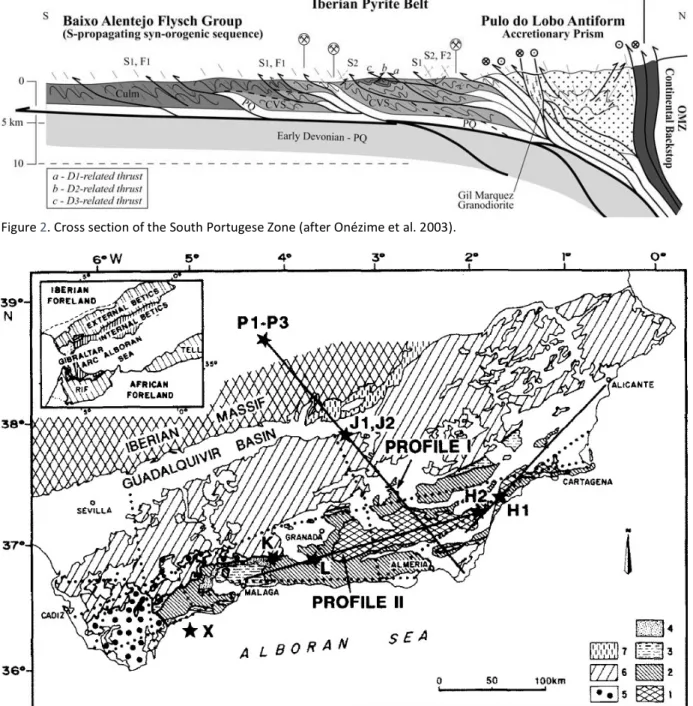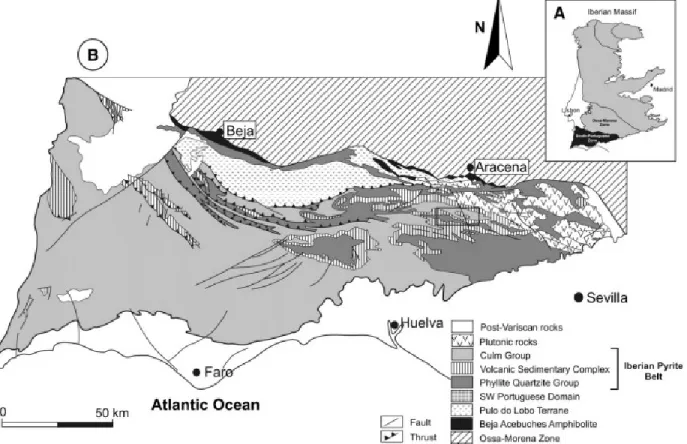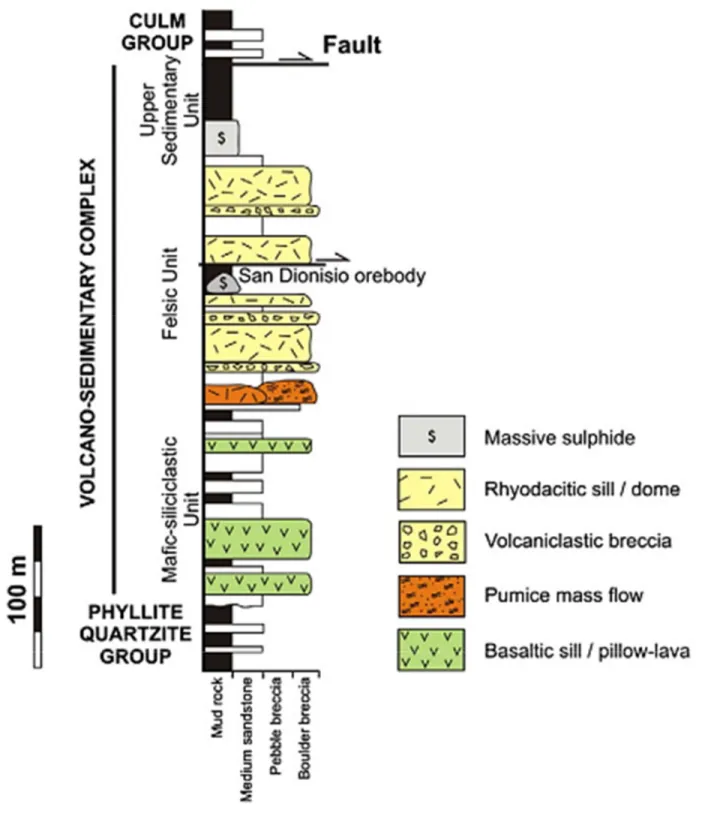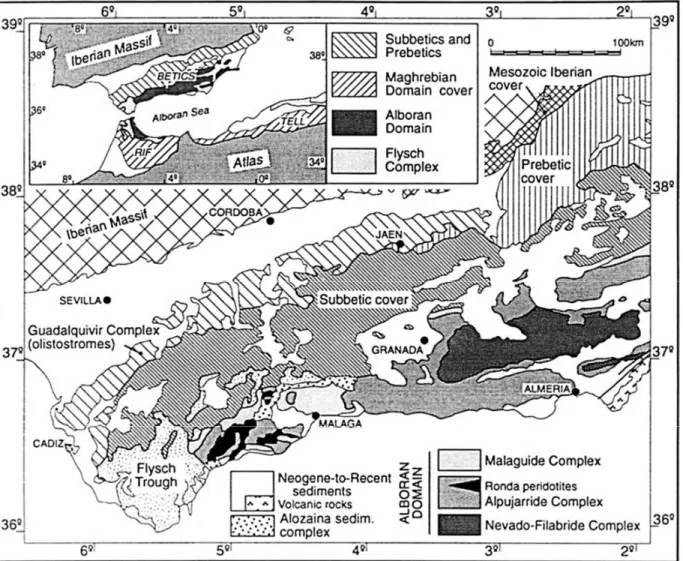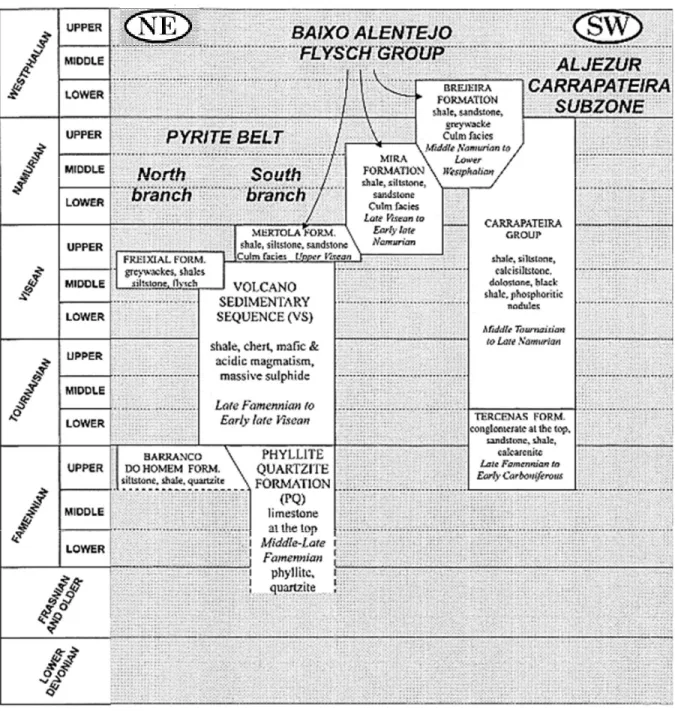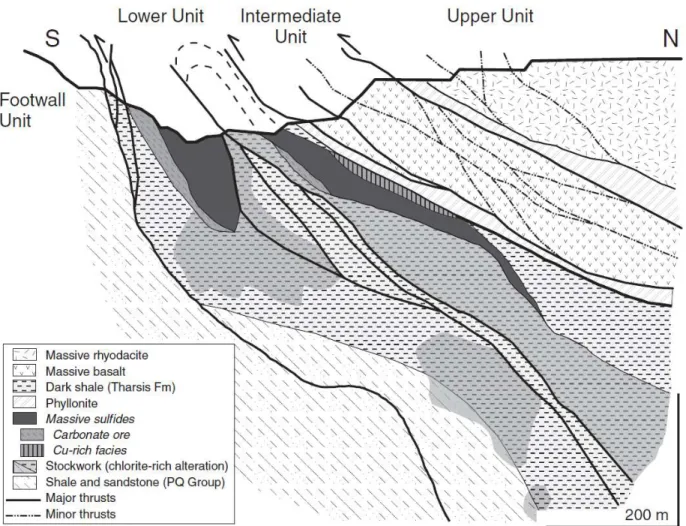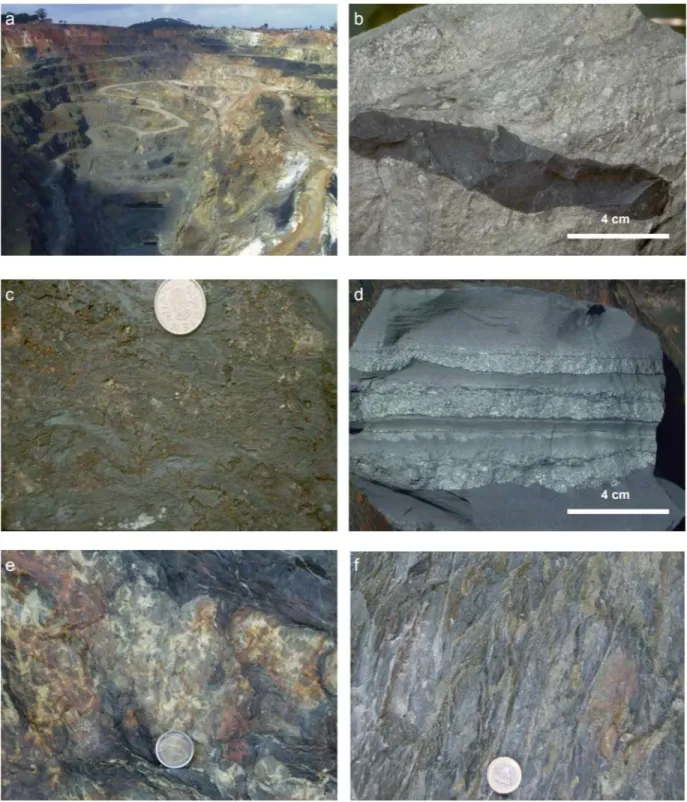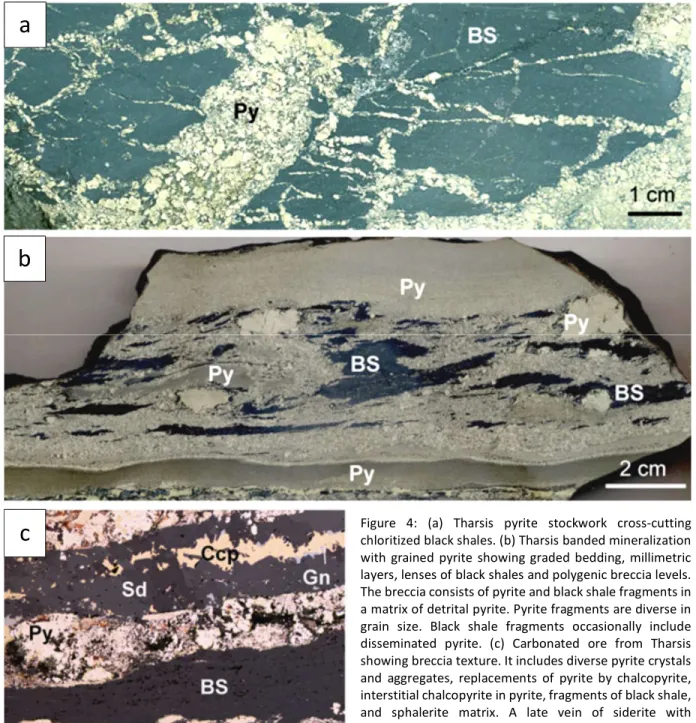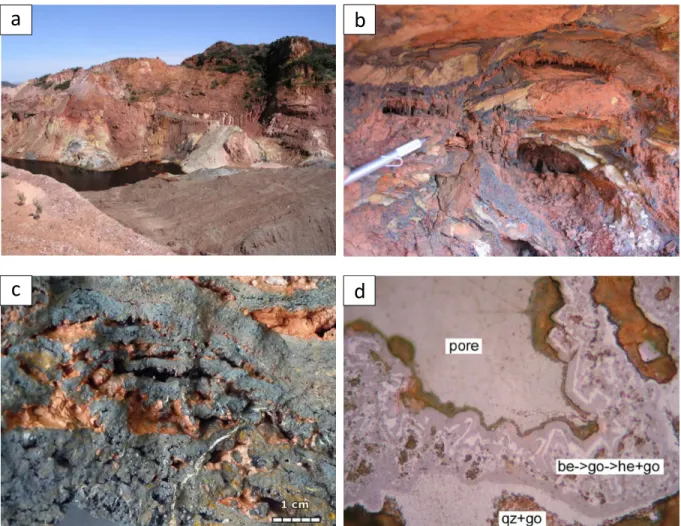Research Collection
Educational Material
SW Spain Ore Deposits Field Guide
Author(s):
Reyes A., Julián M.; Bernard, Cyrielle; Cortés-Calderon, Edgar A.; de Selva-Dewint, Thomas; Gaetan, Link;
Kahou, Zia S.; Arnold, Jeremias; Ligueza, Gabriela; Benz, Jean-Marc; Bongiovanni, Mauro Publication Date:
2019-04
Permanent Link:
https://doi.org/10.3929/ethz-b-000340437
Rights / License:
In Copyright - Non-Commercial Use Permitted
This page was generated automatically upon download from the ETH Zurich Research Collection. For more information please consult the Terms of use.
ETH Library
SW Spain Ore Deposits
Field guide
Edited by Julian Reyes and Cyrielle Bernard Institute of Geochemistry and Petrology
19 – 28 April, 2019
Figures of (top-left to bottom-right):1.Absorption depths of the 1st, 2nd and 3rd feature, displayed in an RGB color composite.
From van der Meer, F., et al. (2018). "Wavelength feature mapping as a proxy to mineral chemistry for investigating geologic systems: An example from the Rodalquilar epithermal system." International Journal of Applied Earth Observation and Geoinformation 64: 237-248. 2. Native gold on quartz matrix from Rodalquilar, Níjar, Almeria, Andalusia, Spain. From https://www.minfind.com/mineral-591663.html (retrieved on 11.03.2019).3.Chromitite on the Ronda ultramafic complex from González-Jiménez, Jose & Griffin, W & Proenza, J & Gervilla, Fernando & O’Reilly, Suzanne & Akbulut, Mehmet & J. Pearson, Norman & Arai, Shoji. (2014). Chromitites in ophiolites: How, where, when, why? Part II. The crystallization of chromitites. Lithos.
189. 140-158. 10.1016/j.lithos.2013.09.008.4.3D geological model of the Rio Tinto VMS deposits. From Martin-Izard, A., et al.
(2016). "Ore deposit types and tectonic evolution of the Iberian Pyrite Belt: From transtensional basins and magmatism to transpression and inversion tectonics." Ore Geology Reviews 79: 254-267.5. Goethite from Cerro Colorado, Rio Tinto Mines, Huelva, Andalusia, Spain. From https://www.mindat.org/photo-397110.html (retrieved on 11.03.2019).6. Mercury on cinnabar from Almadén Mine, Almadén, Ciudad Real, Castile-La Mancha, Spain. From https://www.mindat.org/photo-226733.html (retrieved on 11.03.2019).7. Geological map of western part of 14th Level, Almadén Mine. From Palero-Fernandez, F. J., et al.
(2015). "Geological context and plumbotectonic evolution of the giant Almaden Mercury Deposit." Ore Geology Reviews 64: 71-88.
8. Epidote, quartz and andradite from Aguablanca Mine, Monesterio, Badajoz, Extremadura, Spain. From https://www.mindat.org/photo-225928.html (retrieved on 11.03.2019).9.Reflected-light optical micrographs in semi-massive ore samples from the Aguablanca Ni-Cu sulphide deposit; Py, pyrite; Po, pyrrhotite; Pn, pentlandite; Ccp, chalcopyrite. From Pina, R., et al. (2013). "Platinum-group elements-bearing pyrite from the Aguablanca Ni-Cu sulphide deposit (SW Spain): a LA-ICP-MS study." European Journal of Mineralogy 25(2): 241-252.10.Photomicrographs of a marble (cross-polarized light). From Ganino, C., et al. (2014). "Metamorphic degassing of carbonates in the contact aureole of the Aguablanca Cu-Ni-PGE deposit, Spain."
Contributions to Mineralogy and Petrology 168(3): 21.
Acknowledgements
Field Guide:
SW Spain Ore Deposits
Contributions
The contributions to the field guide were compiled from the literature by the students of the society of economic geologists (SEG) student chapter of ETH Zurich and Universite Toulouse III Paul Sabatier, who take responsibility for correct referencing of data sources, to the best of their knowledge. There is no own research beyond the literature study involved.
Support
We gratefully acknowledge the financial support by the Institute of Geochemistry and Petrology of ETH Zurich. We appreciate the logistical and scientific support of Dr. Lola Yesares, Dr. Fernando Tornos and, current Ph.D. student, Leslie Logan.
Published in the ETH Research Collection, April 2019, © ETHZ 2019
ISBN:978-3-906916-59-0 DOI:10.3929/ethz-b-000340437
38°
MACIZO VARISCO IBERICO 50km
37°
7° 6° 5°
ZC Zona Cantábrica
ZAOL Zona Asturoccidental-Leonesa ZCI Zona Centroibérica
ZOM Zona de Ossa Morena ZSP Zona Surportuguesa P.C. Pirineos y Catalánides
4°
N
38°
37°
3° 2°
Contents
1. Geology of southern Iberian Peninsula. . . . 1 Gaetan Link
2. Magmatic record in southern Spain. . . . 7 Edgar Alejandro Cortes Calderon
3. The Rodalquilar epithermal gold-deposit. . . . 11 Jeremias Arnold
4. Podiform chromite in the Serrania Ronda, Southern Spain. . . . 14 Jean-Marc Benz
5. Iberian Pyrite Belt geology. . . . 17 Cyrielle Bernard
6. Tharsis VMS deposits: Shale Hosted Massive Sulfide. . . . 20 Julian Mauricio Reyes Alvarez
7. Description of the Iberian Pyrite Belt (IPB) hidrothermal fluids. . . 28 Zia Kahou
8. Las Cruces VMS deposits: Supergene alteration. . . 32 Julian Mauricio Reyes Alvarez
9. Rio Tinto : The Mars-like VMS deposit. . . 39 Mauro Bongiovanni
10. The Aguablanca Ni-Cu-PGE ore deposit. . . 45 Thomas de Selva-Dewint
11. Geology, geochemistry and formation of the giant Almadén Mercury deposit. . . 52 Gabriela Ligueza
1
1. Geology of southern Iberian Peninsula
Gaétan Link Introduction
The Iberian Peninsula, also known as Iberia, is located at the southwest of Europe. It outcrops one of the most complete Paleozoic sedimentary successions in Europe in the western (Iberian Massif) and northern massifs (Cantabrian Massif and Pyrenees) (Gibbons and Moreno, 2002). These rocks have been deformed and metamorphosed during the Variscan orogenesis (380-280 Ma). The center and the eastern Iberia consist of sedimentary basins filled by Mesozoic and Cenozoic sediments. The Peninsula is delimited by the Pyrenees belt at the North, which formed during the collision between Iberia and Europe, and the Betic and Catalan coastal ranges at the East, which formed during the western Mediterranean opening and the collision between Iberia and Africa (fig.2).
Geological evolution
Originally, Iberia was a promontory of the northern margin of Gondwana made of a Proterozoic basement.
This particular position formed the Iberian-Armorican arc of the Variscan orogen (fig.1). Gondwana and Laurussia collided in Carboniferous times, which closed the Rheic Ocean and formed the Variscan orogen. The Paleozoic sedimentary succession of Iberia was overthrusted to the north by allochthon nappes and accreted blocs. Iberia is affected by a polyphased deformation and crustal thickening, which induced a barrovian metamorphism. During the Carboniferous-Permian transition, a second LP/HT metamorphism phase induced crustal partial melting and formation of syn-deformation granitoids, related to extension tectonics.
The Variscan belt collapsed during the Permian period and formed fault-related continental sedimentary basins, where acidic volcanism is active. The opening of the Neo-Tethys at the Triassic period separated Iberia to the rest of Gondwana, as it were progressively isolated from Europe by the early rifting of the Bay of Biscay at the beginning of the Jurassic period. During the Mesozoic, Iberia was a subsident area with intracratonic basins that formed epicontinental seas. These basins were mainly filled by marine carbonate deposits. Only a western landmass (the so-called Iberian massif) remained. During the Cretaceous period, Iberia was separated from Europe due to the opening of the Bay of Biscay, following a counterclockwise rotation. As a consequence Figure 1: Sketch structural map of Variscan belt of Europe (after Cochelin et al. 2017).
2
of the northward cinematic of Africa, Iberia moved to the North and collided Europa during the Cenozoic and formed the Cantabrian-Pyrenees belt. The collision between former continental blocks of the western Mediterranean and southern Iberia formed the Betic and Rif Cordilleras.
Iberian massif
The Iberian massif is the main geological unit of the western Iberia. The Variscan basement is exhumed and three main structural units have been recognized: the Central Iberian Zone, the Ossa Morena Zone and the South Portugese Zone (fig.3).
Figure 2: Simplified geological map of Iberian peninsula (modified after PePeEfe, Wikimedia Commons, https://commons.wikimedia.org/wiki/File:Iberian_Peninsula_geological_map_EN.svg, CC-BY-SA 4,0)
Central Iberian Zone
The Central Iberian Zone (CIZ) corresponds to the former northern Gondwana margin. The CIZ have been deformed and metamorphosed during the Ediacaran Cadomian orogeny. During the Paleozoic, the area was a
3
passive margin along a rifting zone, in proximal position, with clastic sedimentation (López-Guijarro et al.
2008). The CIZ was affected by a first Devonian ductile deformation stage, followed by a second deformation stage during the Carboniferous. These deformations stages are related to the Variscan orogeny, where the metamorphic conditions remained in low-greenschist facies conditions (Martínez Poyatos et al. 2001). The CIZ is in tectonic contact with the Ossa Morena Zone through the Badajoz-Córdoba Shear Zone (BCSZ). The BCSZ is interpreted as an Ediacaran suture zone, reactivated during the Variscan orogenesis (López-Guijarro et al.
2008).
Figure 1: Zonal division of the Iberian Massif (López-Guijarro et al. 2008).
Ossa Morena Zone
The Ossa Morena Zone (OMZ) is a former accreted continental bloc, which was located between Laurussia and Gondwana. The OMZ was affected by the Cadomian orogenesis (620-480 Ma). It corresponds to a former post- collisional volcanic arc with calc-alkaline magmatism (Ordoñez Casado 1998). This event was followed by back- arc extension, tectonic inversion, crustal thickening and cratonization in an Andean-type continental margin.
Then, the area recorded an early Paleozoic continental rifting with marine sedimentation. The Cadomian basement and the Paleozoic cover were affected by low-grade tectono-metamorphic events related to the Variscan orogenesis in the 390-300 Ma interval (Eguiluz et al. 2000).
South Portugese Zone
The South Portugese Zone (SPZ) is the southernmost domain of Variscan Iberian massif. It is a part of the Avalonia continental bloc (southern margin of Laurussia). The SPZ is subdivided into three main structural units: the Pulo do Lobo Antiform (PLA), the Iberian Pyrite Belt (IPB) and the Baixo Alentejo Flysch Group (BAFG) (fig.4). The SPZ have been deformed during the continental collision, where the Paleozoic cover was folded and thrusted to the south (thin-skinned tectonics) (fig.). The Pulo do Lobo Antiform is a former accretionary prism, made of turbiditic sedimentary succession, strongly folded and faulted. The Iberian Pyrite Belt is interpreted as a former volcanic arc active during the subduction of Laurussia below the Ossa Morena Zone.
The IPB is made of a sedimentary formation with native and exotic material reworked into a fine-grained pelitic
4
matrix. Volcanic-sedimentary complex are present, associated to caldera structures. Many VMS deposits are also present along the IPB. The Baixo Alentejo Flysch Group formed during the continental collision following the IPB subduction. The BAFG is principally made of flysch sequence of Lower Carboniferous age. The sedimentary succession was folded and thrusted to the south during the thin-skinned tectonics phase.
The South Portugese Zone is accreted to the Ossa Morena Zone along the Beja-Acebuches Ophiolitic Complex.
This complex is interpreted as the Rheic Ocean suture, where a former small oceanic crust (back-arc or transtensional basin) is obducted. It is principally made of amphibolites strongly deformed by sub-vertical mylonite. It is thrusted to the north by granulites of the Ossa Morena Zone (Onézime et al. 2003).
Figure 3. Simplified geological map of the Betic Cordillera and position of the Gadalquivir basin (after Banda et al. 1993).
1 = Nevado-Filbrides nappe. 2 = Alpujarrides complex. 3 = Malaguides complex. 4 = Early Miocene deposits (Alboran domain). 5 = Flysch Trough units. 6 = Sedimentary cover of the external Betics. 7 = Cover of the Iberian massif.
Figure 2. Cross section of the South Portugese Zone (after Onézime et al. 2003).
5
Betic Cordillera and its foreland basins
The Betic Cordillera, as known as Betic Ranges, was formed during the Cenozoic convergence between Africa and Iberia. It is a mountain belt in southeastern Spain, which is a part of the Gibraltar Arc, as the Rif Cordillera (Morocco). The Betic Cordillera was formed by the collision between Iberia and little continental blocs (named as AlKaPeCa), initially located between Africa and Iberia. A continental subduction of the Iberian crust below the Betic Cordillera and the Alborán Sea have been identified by Morales et al. (1999). This subduction is proposed as source of intermediate-depth earthquakes in the area. The Betic Cordillera is divided into two main domains: the Internal Betics (South) and the External Betics (North). The Internal Betics domain is related to AlKaPeca continental block. The External Betics domain is the deformed former Iberian margin. The thickening process induced by the continental collision produced a HP-LT metamorphism coeval with the nappe stacking tectonics. The compressional regime was followed by an extensional regime during the Miocene period (23-12 Ma). The extensional strain was mainly accommodated along detachment faults in the internal domain (Jabaloy et al. 1993).
Guadalquivir basin
The Guadalquivir basin is located to the north of the Betic Cordillera (fig.5). This basin is interpreted as the Betic foreland basin. It is filled by Neogene to Quaternary marine sedimentary rocks. Northward, the sediments of the Guadalquivir basin shows an unconformity with Paleozoic series of the Iberian massif (Azañon et al. 2002).
References
Azañon J.M., Galindo-Zaldívar J., García-Dueñas V. & Jabaloy A. (2002). Alpine tectonics II: Betic Cordillera and Balearic Islands. In: Gibbons W. & Moreno T. (ed), Geology of Spain, The Geological Society, London, pp. 401-416.
Banda E., Gallart J., García-Dueñas V., Dañobeitia J.J. & Makris J. (1993). Lateral variation of the crust in the Iberian Peninsula: new evidence from the Betic Cordillera. Tectonophysics, 221, 53-66.
Cochelin B., Chardon D., Denèle Y., Gumiaux C. & Le Bayon B. (2017). Vertical strain partitioning in hot Variscan crust: Syn-convergence escape of the Pyrenees in the Iberian-Armorican syntax. Bull. Soc. Géol. Fr., 188, 39.
Eguiluz L., Gil Ibarguchi J.I., Abalos B. & Apraiz A. (2000). Superposed Hercynian and Cadomian orogenic cycles in the Ossa-Morena zone and related areas of the Iberian Massif. GSA Bulletin, 112:9, 1398-1413.
Gibbons W. & Moreno T. (2002). Introduction and overview. In: Gibbons W. & Moreno T. (ed), Geology of Spain, The Geological Society, London, pp. 1-7.
Jabaloy A., Galindo-Zaldívar J. & González-Lodeiro F. (1993). The Alpujárride-Nevado-Fibábride extensional shear zone, Betic Cordillera, SE Spain. Journal of Structural Geology, 15:3-5, 555-569.
López-Guijarro R., Armendáriz M., Quesada C., Fernández-Suárez J., Brendan Murphy J., Pin C. & Bellido F.
(2008). Ediacaran-Paleozoic tectonic evolution of the Ossa Morena and Central Iberian zones (SW Iberia) as revealed by Sm-Nd isotope systematics. Tectonophysics, 461:4, 202-214.
Martínez Poyatos D., Nieto F., Azor Antonio & Fernando Simancas J. (2001). Relationships between very-low- grade metamorphic and tectonic deformation: examples from the southern Central Iberian Zone (Iberian Massif, Variscan Belt). Journal of the Geological Society, 158, 953-968.
Morales J., Serrano I., Jabaloy A., Galindo-Zaldívar J., Zhao D., Torcal D., Vidal F. & González-Lodeira F. (1999).
Active continental subduction beneath the Betic Cordillera and the Alborán Sea. Geology, 27:8, 735- 738.
Onézime J., Charvet J., Faure M., Bourdier J.-L. & Chauvet A. (2003). A new geodynamic interpretation for the South Portugese Zone (SW Iberia) and the Iberian Pyrite Belt genesis. Tectonics, 22:4, 1027.
Ordoñez Casado Berta (1998). Geochronological studies of the pre-Mesozoic basement of the Iberian Massif : the Ossa Morena zone and the Allochthonous Complexes within the Central Iberian zone. Thesis, ETH Zürich.
6
2. Magmatic record in southern Spain
Edgar Alejandro Cortes Calderon Introduction
Magmatism is a remarkably efficient mechanism to transport and focus elements of economic interest in the crust (Annen and Zellmer, 2008). The nature of magmas (i.e. mixtures of crystals, melts and gases) and their evolutionary trends trigger a selective sieving of elements (Hedenquist and Lowenstern, 1994; Annen and Zellmer, 2008). This element sorting is P-T-fO2 dependent and follow the degree of compatibility between a chemical element and the vapor, liquid or solid phase in a magma (Annen and Zellmer, 2008). Therefore, understanding how magmas are generated, stored and erupted has important implications in ore genesis and prospection (Arndt and Ganino, 2011).
South Spain
Southern Spain has recorded multiple events of magmatism through the geological time (Onézime et al., 2003;
Tornos et al., 2004; Valenzuela et al., 2011). Some of these magmatic products host ore bodies such as the world-class deposit Iberian Pyrite Belt (IPB) (Onézime et al., 2003; Valenzuela et al., 2011). There are two important magmatic episodes during the Paleozoic related to ore deposits: 1) an Early Paleozoic phase linked with the fate of the Cadomian arc (Tornos et al., 2004); 2) a Late Paleozoic phase associated to the accretion of the South Portuguese Zone (SPZ) (Tornos et al., 2004). A third main magmatic pulse occurred during the Cenozoic related to the Alpine orogeny (Arribas et al., 2005). The aim of this chapter is to review the characteristics of the igneous rocks related to the above-mentioned magmatic episodes (Fig. 1).
Fig. 1. Geological Map of the South Portuguese Zone and the Ossa-Morena Zone. Location of the IBERIAN Pyrite Belt and the Pre- and Post- Variscan lithologies. Obtained from Valenzuela et al., 2011.
7
Paleozoic magmatism
The Southern part of the Iberian Peninsula was characterised by series of amalgamation and rifting events during the Paleozoic (Sarrionandia, 2012 and references therein). These tectonic processes led to the formation of magmas by hydration and adiabatic decompression (Tornos et al., 2004; Sarrionandia, 2012).
The Ossa-Morena zone (OMZ), a polyphase terrane, records subduction-like magmatism during the Neoproterozoic and extensional magmatism that led the opening of the Rheic Ocean during the Cambrian- Ordovician periods (Tornos et al., 2004; Sarrionandia, 2012). The IPB, a vast Devonian complex, hosts eight giant volcanogenic massive sulphide (VMS) deposits.
The Cadomian terrane
After the amalgamation of the Cadomian arc (i.e. the so-called OMZ) along the NW edge of Gondwana during the Neoproterozoic-Cambrian transition, a major rifting event led the formation of the Rheic Ocean (Sarrionandia, 2012). This continental break-up is recorded by volcanosedimentary rocks that belong to the OMZ (Sarrionandia, 2012). After the rifting event a new accretion processes (i.e. Variscan orogeny) trigger the metamorphism of the OMZ (Tornos et al., 2004). The ore deposits related to this terrane comprise: 1) arc- related VMS and minor porphyry-Copper mineralisation during the formation of the Cadomian arc in the Cadomian orogeny (Tornos et al., 2004); 2) iron oxide stratabound deposits during the opening of the Rheic Ocean (Tornos et al., 2004); 3) orogenic deposits (i.e. Hg, U, Au, Cu-Ni ores) related to transpressional strain during the Variscan orogeny (Tornos et al., 2004).
The Cadomian arc is the result of Andean-type volcanism (i.e. subduction magmatism) with a calc-alkaline chemical evolution (Tornos et al., 2004). Andesitic-dacitic plutons and volcanic desposits are the main constituents of this arc (Tornos et al., 2004). Although the ore deposits related to this arc are scare, a subordinate back-arc represents the main environment for ore accumulation (i.e. VMS and SEDEX) during this period (Tornos et al., 2004). No epithermal deposits have been found to date, and Au-orogenic deposits in the OMZ are more related to the Variscan rather than the Cadomian orogeny (Tornos et al., 2004).
The opening of the Rheic ocean led the formation of a rifting event (Sarrionandia, 2012). The rocks from this stage comprise moderately alkaline ultrabasic to acid units (Sarrionandia, 2012). Geochemical analyses of these units exhibit an OIB-type source (Sarrionandia, 2012). The chemical diversity of this volcanic sequence is attributed to fractional crystallisation of plagioclase, clinopyroxene and amphibole with a minor component of crustal assimilation (Sarrionandia, 2012). There are two types of primitive melts that are characterised by different amounts of partial melting of the sublithospheric mantle (Sarrionandia, 2012). It is noteworthy that this magmatic episode is not related to MORB-type magmatism, but hotspot-type that contribute to the continental break up (Sarrionandia, 2012). The ore bodies in these volcanosedimentary sequences are restricted to iron oxide stratabound deposits that are favoured by rifting conditions (Tornos et al., 2004).
The accretion of the SPZ was charaterised by a subduction regime and metamorphic pulses that altered the units described above in different proportions (Onézime et al., 2003; Tornos et al., 2004). This Late Paleozoic event corresponds to the Variscan orogeny and led the more economic important ore accumulation in the OMZ (Tornos et al., 2004). Magmatic pulses (arc-related) are related to pull-apart basins that were produced due to transpressional-type stresses (Tornos et al., 2004). Calc-alkaline signatures are found in the volcanic sequences and plutons, which confirm the presence of subduction tectonics (Tornos et al., 2004). Variscan intrusions are mainly metalumuous ranging from gabbros to monzogranites (Tornos et al., 2004). The cumulates related to the Variscan plutons in the OMZ host important Ni-Cu ore bodies (Tornos et al., 2004).
Subsequent increase in stress rates led to replacement of arc-related deposits triggering the formation of orogenic ore bodies and veins (Tornos et al., 2004).
Accretion of the South Portuguese Zone
The SPZ is a continental fragment that was accreted to the OMZ edge during the Late Paleozoic (i.e. Variscan orogeny) (Onézime et al., 2003; Valenzuela et al., 2011). This terrane hosts the world-class ore deposit IPB, which consists mainly of VMS-like deposits (Valenzuela et al., 2011). The ore bodies are located specifically in
8
the volcano-sedimentary complex (Fig. 2). Lithofacies analysis through Odiel river section reveals that the sequence records a submarine eruption environment (e.g. ash-poor, thick lava packages, little or no sediments interbedded) (Valenzuela et al., 2011). The presence of mafic facies decreases upwards the section and the massive sulphides are hosted in the upper sedimentary and felsic unit (Valenzuela et al., 2011).
Fig. 2. Odiel section showing the Iberian Pyrite Belt sequence. Obtained from Valenzuela et al. (2011).
9
The tectonic setting linked to the volcanism in this area is still a matter of debate (Onézime et al., 2003;
Valenzuela et al., 2011). Furthermore, there is no agreement whether the genesis of the ore bodies is related to the volcanism or just a consequence of basinal fluids (Onézime et al., 2003; Valenzuela). The works that link the volcanism with massive sulphides genesis argue that the felsic stage should be related to an arc environment, where dome-collapses could be possible. However, the abundance of massive sulphides in this area makes unrealistic the arc-setting as the unique agent for ore accumulation (Valenzuela, et al., 2011).
Cenozoic magmatism
Further accretion events occurred during the Alpine orogeny (López-Ruiz, 1999). Extensional regimes are triggered to compensate the new thickness of the crust. This volcanism formed a caldera above a felsic magma chamber during the Miocene (López-Ruiz, 1999). The development and collapse of this caldera (i.e. Rodalquilar caldera) produced dacitic domes and ignimbrites with a calc-alkaline signature (López-Ruiz, 1999). Economic Au accumulation in the explosive phase of Rodalquilar volcanism (Arribas, et al., 2005). The importance of calderas relies on the creation of fractures, which work as pathways for fluid flow (Arribas, et al., 2005).
Therefore, calderas structures are important places for hydrothermal alteration, which is related to ore accumulation (Arribas, et al., 2005).
References
Annen, C., Zellmer, G.F., (2008). Dynamics of crustal magma transfer, storage and differentiation. Geological Society of London, p. 288
Arribas, A., Hernández. F., Fernández, M.A., Gröbner, J., Leal, G., (2005). Bocamina. Revista de Minerales y Yacimientos de España. Vol. 15
Arndt, N., Ganino, C., (2011). Magmatic Ore deposits. In: Metals and Society. Metals and Society. Vol 2.
Springer, Heidelberg.
Hedenquist, J., Lowenstern, J.B., (1994). The role of magmas in the formation of hydrothermal ore deposits.
Nature. Vol. 370.
Onézime, J., Charvet, J., Faure, M., Bourdier, J-L., Chauvet, A., (2003). A new geodynamic interpretation for the South Portuguese Zone (SW Iberia) and the Iberian Pyrite Belt. Tectonics. Vol. 22.
López-Ruiz, J., (1999) El campo volcánico del neógeno del SE de España. Enseñanza de las ciencias de la tierra.
Sarrionandia, F., Carracedo-Sanchez, M., Eguiluz, L., Ábalos, B., Rodríguez, J., Pin, C., Gill-Ibarguchi, J.I., (2012).
Cambrian rift-related magmatism in the Ossa-Morena Zone (Iberian Massif): Geochemical and geophysical evidence of Gondwana break-up. Tectonophysics. Vol. 570-571. p, 135-150.
Tornos, F., Inverno, M.C., Casquet, C., Mateus, A., Ortiz, G., Oliviera, V., (2004). The metallogenic evolution of the Ossa-Morena Zone. Journal of Iberian Geology, Vol. 30. p. 143-181.
Valenzuela, A., Donaire, T., González-Roldán, M.J., Toscano, M., Pascual, E., (2011). Volcanic architecture in the Odiel river área and the volcanic environment in the Riotinto-Nerva Unit, Iberian Pyrite Belt, Spain.
Vol. 202. P.29-46.
10
3. The Rodalquilar epithermal gold-deposit
Jeremias Arnold Mining history
Mining of galena-quartz veins began in the second half of the eighteenth century. Gold was discovered in 1883 and subsequently mined from small operations. Significant gold mineralization in the present mining area has been outlined by geochemical methods in 1942, with estimated reserves of four million tons with ore grades of 4.5 ppm gold. Opencast and underground mining was carried out from 1956 to 1966. During this period some three million tons of rock have been removed, of which 1.5 million tons had an average grade of 6.5 - 7 ppm gold (Oepen et al. 1989; Rytuba et al. 1990).
Figure 1: Simplified geology of the Rodalquilar district, showing deposits associated with the caldera-related radial and concentric faults. Obtained from Oepen (1989).
Geological Setting
The area between Almeria and Cartagena shows a wide spectrum of posttectonic Neogene magmatic activity, ranging from calc-alkaline andesite via ultrapotassic rocks to alkali basalts (Lopez-Ruiz and Rodriguez Badiola 1980; Bellon et al. 1983; Venturelli et al. 1984; Bordet 1985; Torres-Roldan et al. 1986). The volcanic rocks of the Sierra del Cabo de Gata (SCG) ranging 14-18 Ma were grouped into four major phases. Complex A consists in pyroxene- and hornblende-bearing andesite with age-equivalent tuffs overlained by hornblende-andesites of complex B. Dacites and rhyolites of complex C are found in the central SCG. The final volcanic phase, complex D, consists of dark pyroxene andesites. Gold mineralization is hosted in the rhyolites and rhyodacites of complex C, in the so called Cinto complex, and found in the eastern wall of the Lomilla caldera. The tectonic pattern is dominated by radial and ring fractures towards the Cerro Cinto and gold mineralization is largely confined to these caldera-related faults (Oepen et al. 1989).
11
Figure 2: Lithogeochemical profiles perpendicular to the vein structure. Oxides are given in wt%, elements in ppm. Obtained from Oepen (1989).
Alteration
Intensive alteration of volcanic host rocks have transformed the primary mineral paragenesis to the extent that only primary quartz phenocrysts remained unaffected. Altered rocks consist of quartz, alunite, kaolinite, jarosite, pyrophyllite and hematite. Zoning ranges from advanced argillic alteration in and close to gold-mineralized structures towards argillic and more regionally developed propylitic alteration (Lodder 1966). In some areas, pockets of extremely high grade gold mineralization exceeding 500 ppm can be found (Martin-Vivaldi et al. 1971). Supergene replacement reactions can be observed and form very fine gold (Oepen et al. 1989).
Fluids
Two fluids with different origins and compositions were distinguished. A hypersaline, acid fluid of magmatic origin can be characterized by its NaCl and KCl content, hematite and other unidentified daughter minerals. When overpressured and overheated, fluids escaped from the parental magma through caldera-related fractures, violent boiling lead to variable liquid contents and different amounts of salt crystals in those inclusions. A low-salinity fluid with 3-5 equiv. wt% NaCl is assumed to derive from seawater.Fluid inclusions Fluid inclusions
In order to get information on vertical changes in P-T-X conditions of hydrothermal fluids, micro-thermometric investigations were performed on drill core samples over a depth of 650 m. Based on phase relationships, two- phase, liquid-rich fluid inclusions (type 1), multiphase fluid inclusions with up to four daughter minerals (type 2) and vapor-rich or vapor-filled inclusions (type 3) were described by Oepen et al. (1989). Vapor-rich inclusions of type 3 can be linked to either type-1 or type-2 inclusions on the basis of comparable salinities or similar daughter crystals. Microthermometric investigations also revealed widespread evidence of boiling throughout the investigated depth interval.
From pressure, a paleosurface of 50 m above the present is estimated, which also agrees with geologically inferred evidence (Hernandez 1988).
Generic model Timing
The mineralization is closely associated with hornblende-andesite intrusives and flows, which corresponds to the youngest volcanic activity within the Rodalquilar caldera. Only some of the hornblende-andesites are altered and mineralized, indicating that mineralization occurred during the early phase of andesitic volcanism but ended before the last flows emplaced, at 9.0±0.6 Ma.
Potassium-argon dating of alunite and illite from the alteration zones associated with gold deposits range from 9.5±0.5 Ma to 11.3±0.4 Ma for Illite and 10.3±0.4 Ma to 10.6±0.5 Ma for alunite (Arribas et al. 1989).
Gold mineralization
The Rodalquilar gold-alunite deposits are closely related in time and space to porphyritic, intermediate composition magma emplaced along caldera
12
structures, but unrelated to the caldera forming the magmatic system (Rytuba et al. 1990). Gold mineralization and advanced alteration are considered to have evolved from hyper saline and overpressured solutions in the near-surface environment. Episodic pressure releases due to fracturing of rocks or widening of conduits must have caused fluids to boil. Low-salinity fluids of marine origin flowed into the fractured system and interacted with both the wallrock and the magmatic fluids. High-grade gold mineralization occurs within the upper 50 m below surface, with decreasing Au contents down to about 120 m. This corresponds to the depth interval at which low-salinity fluids maintained homogenization temperatures of 175°C.
It is suggested that fluid boiling was accompanied by a H2S loss as vapor. Subsequent oxidation of H2O to H2SO4 in superjacent fluids caused an important decrease in pH (Henley 1985; Fournier 1985; Hayba et al.
1985). Reactions between acid fluids and silicates from wallrocks may have released silica into the fluids, causing significant supersaturation with respect to quartz or even formation of calcedony. The leaching of wallrock was connected with volcanogenic activity (Hedenquist et al. 1988). This physiochemical environment during acid alteration was favorable to the formation of gold mineralization since the decrease in pH and increase in fO2 favor gold precipitation when transported as a bisulfide complex (Seward 1984).
References
Arribas Jr, A., Rytuba, J. J., Rye, R. O., Cunningham, C. G., Podwysocki, M. H., Kelly, W. C., ... & Smith, J. G.
(1989). Preliminary study of the ore deposits and hydrothermal alteration in the Rodalquilar caldera complex, southeastern Spain (No. 89-327). US Dept. of the Interior, US Geological Survey,.
Bellon, H., Bordet, P., & Montenat, C. (1983). Chronologie du magmatisme néogène des Cordillères bétiques (Espagne méridionale). Bulletin de la Société géologique de France, 7(2), 205-217.
Bordet, P. (1985). Le volcanisme Miocène des Sierras de Gata et de Carboneras, Espagne du Sud-Est (No. 8).
Institut géologique Albert de Lapparent.
Fournier, R. O. (1985). The behavior of silica in hydrothermal solutions. Review in Economic Geology, v., 2, 45- 60.
HAYBA, B. (1985). Geologic, mineralogic and geochemical characteristics of volcanic hosted epithermal precious metal deposits. In Geology and geochemistry of epithermal systems. Rev. Econ. Geol., 2, 129- 167.
Hedenquist, J. (1988). Epithermal gold mineralization of acid-leached rocks in the Nansatsu district of southern Kyushu, Japan. In Gold 1988 Conference (pp. 183-190). Geol. Soc..
Henley, R. W. (1985). The geothermal framework of epithermal deposits. Geology and geochemistry of epithermal systems, 1-24.
Lodder, W. (1966). Gold-alunite deposits and zonal wall-rock alteration near Rodalquilar. Univ. Amsterdam, Geol. Inst., Medeling, (318), 93.
López Ruiz, J., & Rodríguez Badiola, E. (1980). La región volcánica neógena del sureste de España.
Oepen, P. S. V., Friedrich, G., & Vogt, J. H. (1989). Fluid evolution, wallrock alteration, and ore mineralization associated with the Rodalquilar epithermal gold-deposit in southeast Spain. Mineralium Deposita, 24(4), 235-243.
Rytuba, J. J., Arribas, A., Cunningham, C. G., McKee, E. H., Podwysocki, M. H., Smith, J. G., & Kelly, W. C. (1990).
Mineralized and unmineralized calderas in Spain; Part II, evolution of the Rodalquilar caldera complex and associated gold-alunite deposits. Mineralium Deposita, 25(1), S29-S35.
Seward, T. M. (1984). The transport and deposition of gold in hydrothermal systems. Gold'82: The geology, geochemistry and genesis of gold deposits, 165-181.
Torres-Roldán, R. L., Poli, G., & Peccerillo, A. (1986). An Early Miocene arc-tholeiitic magmatic dike event from the Alboran Sea—Evidence for precollisional subduction and back-arc crustal extension in the westernmost Mediterranean. Geologische Rundschau, 75(1), 219-234.
Venturelli, G., Capedri, S., Di Battistini, G., Crawford, A., Kogarko, L. N., & Celestini, S. (1984). The ultrapotassic rocks from southeastern Spain. Lithos, 17, 37-54.
Vivaldi, J. M., Sierra, J., & Leal, G. (1971). Some Aspects of the Mineralization and Wall-rock Alteration in the Rodalquilar Gold-Field, SE Spain. Society of Mining Geologists of Japan
13
4. Podiform chromite in the Serrania Ronda, Southern Spain
Jean-Marc Benz Introduction
Chromite is a Cr-bearing ore (FeCr2O4) that contains mainly Cr- and Al-rich spinel (González-Jiménez et al., 2014). Significant amounts of chromite can be found either in stratiform or podiform chromitite deposits.
Podiform chromitite deposits display high chromium numbers (Cr # = Cr/[Cr + Al] atomic ratio), mostly higher than 0.4, with common values ranging between 0.7 and 0.8 (Arai, 1997). Usually chromitite deposit are restricted to ophiolites, tectonically emplaced oceanic crust and upper mantle sequences over a continental crust. Therein the chromite hosting zones are in the upper mantle or close to the crust-mantle boundary (González-Jiménez et al., 2014). Economically viable chromitite deposits contain approximately 30% Cr. The podiform Ronda chromite deposits are in the Betic-Rifean orgenic belt in Southern Spain (Crespo et al., 2006).
Figure 4: Tectonic map of the Betic Chain with the indicated position of the Ronda peridotites in the Alpujarride Complex.
Obtained from Crespo-blanc (1997).
14
Geological Setting
The Betic and Rif mountain chains form an arc-shaped mountain belt around the Straits of Gibraltar north and south of the Alboran Sea. The mountain chain is made up by four major tectonic domains, namely the Alboran, Sub Iberian, Maghrebian domains, and the allochthonous Flysch trough (Crespo-blanc, 1997, Platt et al., 2013).
Within the internal zone of the Gibraltar Arc the Alpujarride complex is located. The Serrania de Ronda is in the western Alpujarride units of the Betic-Rifean orgogenic belt, the western most part of the Mediterranean Alpine belt in southern Spain (Fig. 1) (Crespo-blanc, 1997). The ultramafic rocks of Serrania de Ronda crop out in three separated mounts, namely the Ronda, Ojén and Carratraca massifs. The Ronda mount host the world’s largest exposed orogenic lherzolites. All three ultramafic mounts are portions of an old (Proterozoic) subcontinental lithospheric mantle tectonically emplaced in the lower crust 22 Ma ago (Crespo et al., 2006).
Formation of podiform chromitite deposits
Podiform or alpine-type chromitites are exclusively found in the mantle and/or the mantle-crust transition zone of ophiolitic complexes or their dismembered equivalents. The best-documented podiform chromitite deposits are in Cyprus and Oman. The crustal thickness at Cyprus is 8 km and at Oman 6 km, the chromitites were formed at a lithostatic pressure of 0.2 GPa including the seawater, lithostatic, pressure.
The name ‘podiform’ is given by the shape of pods of the chromitite enveloped in a dunite. However, they can also cut the surrounding structure of the mantle peridotites (Arai, 1997). Podiform chromite deposits were claimed to be related to mid-ocean ridges, where huge basaltic magma chambers are produced. More recent studies suggest a genesis in a supra-subduction zone environment because of the hydrous character of involved basaltic melts (e.g. Rollinson & Adetunji, 2013; Matveev & Ballhaus, 2002).
Chromium is a compatible lithophile element that gets enriched in the mafic silicate melt fraction with increasing degree of partial melting of primitive mantle. Primitive mantle melts have a chromium concentration of 200-500ppm, so to achieve 30% Cr in bulk ore two enrichment mechanisms are needed. The first mechanism acts at a small scale and leads to physical separation of olivine and chromite at magmatic temperatures, where primitive melts are normally saturated in both species. Chromite concentration is controlled by surface processes where oxides are better wetted by water-rich fluid phase than by silicate melt.
Since the opposite is true for the silicate minerals, chromite-bearing water-rich bubbles coalesce and migrate upward. Accumulation of these bubbles leads to the formation of chromite pools. The second mechanism leads to a large-scale concentration of chromite. The main driving mechanism is the density contrast between chromite-laden fluid pools and silicate melt. Sinking of accumulated chromite bearing bubbles occurs when chromite concentration reaches over 50%. Fast down sinking and insulation by the remaining water-rich fluid phase prevents the chromite from melting. The sheet likes structure is a result from the accumulation by sinking process (Matveev & Ballhaus, 2002).
Figure 5: Genetic model of chromite formation. Left figure shows the ascension of Cr-rich bubbles after exsolution. Right figure shows the descent of aggregated Cr-rich bubbles when attaining a state of negative buoyancy. Obtained from Matveev & Ballhaus (2002).
15
References
Arai, S. (1997). Origin of podiform chromitites. Journal of Asian Earth Sciences, 15(2-3), 303-310.
Crespo-blanc, A. (1997). Continental collision, crustal thinning and nappe forming during the pre-Miocene evolution of the Alpujarride Complex (Alboran Domain, Betics).Journal of Structural Geology,19(8), 1055-1071.
Crespo, E., Luque, F. J., Rodas, M., Wada, H., & Gervilla, F. (2006). Graphite–sulfide deposits in Ronda and Beni Bousera peridotites (Spain and Morocco) and the origin of carbon in mantle-derived rocks. Gondwana Research, 9(3), 279-290.
Gonzalez-Jimenez, J. M., Griffin, W. L., Proenza, J. A., Gervilla, F., O'Reilly, S. Y., Akbulut, M., Pearson, N. J. & Arai, S. (2014).
Chromitites in ophiolites: How, where, when, why? Part II. The crystallization of chromitites. Lithos, 189, 140- 158.
Gutierrez-Narbona, R., Lorand, J. P., Gervilla, F., & Gros, M. (2003). New data on base metal mineralogy and platinum- group minerals in the Ojen chromitites (Serrania de Ronda, Betic Cordillera, southern Spain). Neues Jahrbuch für Mineralogie-Abhandlungen: Journal of Mineralogy and Geochemistry, 179(2), 143-173.
Matveev, S., & Ballhaus, C. (2002). Role of water in the origin of podiform chromitite deposits. Earth and Planetary Science Letters, 203(1), 235-243.
Marchesi, C., Griffin, W. L., Garrido, C. J., Bodinier, J. L., O’Reilly, S. Y., & Pearson, N. J. (2010). Persistence of mantle lithospheric Re–Os signature during asthenospherization of the subcontinental lithospheric mantle: insights from in situ isotopic analysis of sulfides from the Ronda peridotite (Southern Spain). Contributions to Mineralogy and Petrology, 159(3), 315-330.
Platt, J. P., Behr, W. M., Johanesen, K., & Williams, J. R. (2013). The Betic-Rif arc and its orogenic hinterland: a review.Annual Review of Earth and Planetary Sciences,41, 313-357.
Rollinson, H., & Adetunji, J. (2013). Mantle podiform chromitites do not form beneath mid-ocean ridges: A case study from the Moho transition zone of the Oman ophiolite. Lithos, 177, 314-327.
Torres-Ruiz, J., Garuti, G., Gazzotti, M., Gervilla, F., & Hach-Ali, P. F. (1996). Platinum-group minerals in chromitites from the Ojen lherzolite massif (Serrania de Ronda, Betic Cordillera, Southern Spain). Mineralogy and Petrology, 56(1- 2), 25-50.
16
5. Iberian Pyrite Belt geology
Cyrielle Bernard Introduction
The Iberian Pyrite Belt (IPB) is a part of the South Portuguese Zone, located in southern Spain and Portugal. It is made from base to top of the Phyllite-Quartzite Formation (PQF), the Volcano-Sedimentary Complex (VSC), and finally a turbidite named the Culm Group (CG). They all have been deformed during the Variscan orogeny;
their timing of formation is detailed in the next section and summarized in Fig. 1.
The Phyllite-Quartzite Formation (PQF)
The basement of the IPB is made of the PQF, of Late Devonian age (385±2.6 to 359±2.5 Ma), made of an alternation of meter thick quartzites, limestones and dark shales. This unit is the most deformed, however sedimentary structures such as parallel laminations, ripples and bioturbation indicates this unit emplaced in a shallow water environment, probably an epicontinental sea. The summit of the PQF is made of a 30 m thick shales layer, which contains lenses of bioclastic limestones. Fossils such as trilobites, brachyopods and conodonts were found in this top section.
The Volcano-Sedimentary Complex (VSC)
The VSC is made of a mix between sedimentary and volcanic rocks and is 0 to 1300 m thick depending on its proximity to volcanic centres. It is dated as Late Fammenian (~359 Ma) to Late Viséan (~328 Ma) and its contact with the PQF is mainly tectonic. The VSC hosts all volcanic-hosted massive sulphide (VHMS) deposits. Three main volcanic episodes have been recognized and dated between 351±0.4 and 345±0.6 Ma (Valenzuela et al., 2011). From the youngest to the oldest episode, the complex is divided in: (1) rhyolitic pyroclasts and lavas;
(2) rhyolitic to rhyodacitic lavas and pyroclasts; and (3) tuffs and siliceous shales (Dallmeyer and Garcia, 2012;
Soriano and Casas, 2002). The whole sequence is intruded by sills and dikes, comprised by gabbros, diorites, tonalities and granites. Most plutons emplaced after the extension event that affected the IPB. The magmatic evolution is linked to melting of progressively shallower crustal levels and is interpreted as having occurred in an extensional context linked with a mantle plume. This plume was probably mostly active between 355 and 335 Ma (Valenzuela et al., 2011).
The VSC is also divided into a lower autochthonous and an upper allochthonous sections. The autochthonous section is highly deformed and includes several major anticlinal folds such as Alcoutim and Cercal. On the other hand, the allochthonous segment is comprised by the Galé-Cela and Mértola Nappes (Dallmeyer and Garcia, 2012). Both sections have experienced hydrothermal alteration.
The Culm Group (CG)
Finally, the top of the IPB is made of the CG, a Late Viséan to Middle-Late Pennsylvanian (~300 Ma) turbidite.
It consists of shale, litharenite and conglomerate. This flysh is partly made of rocks from the VSC and is interpreted as a consequence of the Variscan orogeny.
Deformation of IPB
Deformation that affects the whole IPB is known to have occurred in three phases. D1 is made of cleavages, folds verging SSW and associated north-dipping thrusts. D2 are the most widespread structures. Cleavages dip NNE, folds are asymmetric and verge to the south, and thrusts dip NNE. Folds are meters to decimeters scale.
These D2 structures affect the D1 event. D3 structures are not well developed and do not interact with D1 and D2 structures. Cleavages can dip to the SSW as well as to the NNE and folds display and E-W trend (Soriano and Casas, 2002). All these deformations are the result of an extensive context and have been used again during the inversion to a compressive context during the Variscan orogeny shaping the actual landscape (Fig.
2). VHMS deposits formed using the preexisting thrusts, that were ideal channels for the circulation of metalliferous hydrothermal fluids (Leistel et al., 1997).
17
Figure 1: Summary of chrono-lithostratigraphic relations inside the South Portuguese, modified from Leistel et al. (1997).
Conclusion
Finally, the proposed scenario for the IBP formation is the following: (1) Rupture of the shallow water detritic platform (PQF) during Upper Famennian to Middle Visean. This resulted in the formation of a rift, which then split in half grabens and began volcanism, probably in relation with a mantellic plume; (2) Following subduction and collision between the southern branch and the Ossa-Morena Zone during the Variscan orogenesis, the extensional regime turned into a compressive one; and (3) gave birth to flysh sedimentation of the Culm Group.
Figure 2: (a) Paleogeographic context of the South Portuguese Zone at the Devonian-Carboniferous transition. (b) Paleogeographic context of the South Portuguese Zone during Upper Viséan. Modified from Onézime et al., 2003. (c) Cross section of the South Portuguese Zone. Obtained from Onézime et al. (2003).
18
References
Dallmeyer, R.D., Garcia, E.M., 2012. Pre-mesozoic geology of Iberia. Springer Science & Business Media.
Leistel, J.M., Marcoux, E., Thiéblemont, D., Quesada, C., Sánchez, A., Almodóvar, G.R., Pascual, E., Sáez, R., 1997. The volcanic-hosted massive sulphide deposits of the Iberian Pyrite BeltReview and preface to the Thematic Issue. Miner. Deposita 33, 2–30. https://doi.org/10.1007/s001260050130
Onézime, J., Charvet, J., Faure, M., Bourdier, J.-L., Chauvet, A., 2003. A new geodynamic interpretation for the South Portuguese Zone (SW Iberia) and the Iberian Pyrite Belt genesis. Tectonics 22.
Soriano, C., Casas, J., 2002. Variscan tectonics in the Iberian Pyrite Belt, South Portuguese Zone. Int. J. Earth Sci. 91, 882–896. https://doi.org/10.1007/s00531-001-0253-8
Valenzuela, A., Donaire, T., Pin, C., Toscano, M., Hamilton, M.A., Pascual, E., 2011. Geochemistry and U–Pb dating of felsic volcanic rocks in the Riotinto–Nerva unit, Iberian Pyrite Belt, Spain: crustal thinning, progressive crustal melting and massive sulphide genesis. J. Geol. Soc. 168, 717–732.
https://doi.org/10.1144/0016-76492010-081 c.
19
6. Tharsis VMS deposits: Shale Hosted Massive Sulfide
Julian Mauricio Reyes Alvarez Introduction
The Tharsis deposit is composed by 16 orebodies of very variable size with more than 133 Mt of ore, hosted in 5 open pits (Filón Norte, Filón Sur, Sierra Bullones, Filón Centro and Esperanza). The biggest mine is Filón Norte open pit, including the Filón Norte, San Guillermo and Sierra Bullones lenses, with at least 88 Mt of ore grading 46.5 wt% S, 2.7 wt% Zn + Pb, and 0.7 wt% Cu. While the gossan at Filón Sur mine contained 15.5 Mt of ore grading 1.7 g/t Au and 29 g/t Ag (Velasco et al., 2013). The district has felsic volcanic and shale rocks that have experienced major hydrothermal alteration with semimassive sulfides, stockwork and disseminated textures (Tornos et al. 2008). In the district, the mineralization could be hosted in volcanic (e.g. Almagrera, Lagunazo, La Lapilla, Filón Sur) and shale (e.g. Filón Norte, Fig. 3a) rocks.
Geological Setting
The main ore bodies are in a ~ 50–300 m thick tectonically complex area, in between tectonic sheets in a shale bearing unit (Lower unit). The bottom tectonic, thrust, contact is with the Phyllite-Quartzite (PQ) Group, located below the Volcanic Sedimentary Complex (VSC). The top contact of the main ore bodies is a tectonic sheet of dark shale with minor jasper intruded by basaltic sills of the VSC (Intermediate unit). The Lower and Intermediate units are the hanging wall of the Puebla de Guzman Nappe, in contact with a mylonitic zone on top, overlain by rhyodacitic subvolvanic sills within dark shales interbedded with felsic volcanoclastics, and microgabro sills of the VSC (Upper unit; Fig. 1, 2) (Conde et al. 2010; Tornos et al. 2008).
Figure 1: Geological setting of the Tharsis VMS deposit. (A) Schematic map of the Variscan Fold Belt in Europe (Oliveira and Quesada, 1998). (B) Detailed geological map of the Tharsis area and location of Filón Norte, San Guillermo and Sierra Bullones lenses (modified from Tornos et al., 2008). (C) General stratigraphic column of Filón Norte open pit, Tharsis, showing the distribution of the different types of mineralization within the orebody (modified from Tornos and Conde, 2002; Tornos et al., 2008). Obtained from Conde et al. (2010).
20
Figure 2: Cross section of the Filon Norte deposit from Tornos et al. (2008) Filón Norte deposit
The igneous and sedimentary sequence adjacent to the orebodies, excluding the microgabbro sills in the Upper unit, has experienced pervasive hydrothermal alteration. Alteration in the Intermediate unit is evidenced as ankeritization, on the other hand, the Upper unit as sporadic sericitization and silicification (Tornos et al.
2008). From palynological dating of the shale hosting the Filón Norte deposit it is interpreted that the age of the Tharsis orebody is late Famennian (González et al., 2002), moreover, this age has been linked to other shale-hosted deposits in the southern Iberian Pyrite Belt (Aznalcóllar: Pereira et al., 1996; Neves Corvo:
Oliveira et al., 2004) and is consistent with the 353±44 Ma and 348.6±12.3 Ma Re–Os ages by Mathur et al.
(1999) and Nieto et al. (2000).
Shale-hosted stockwork mineralization
Chlorite alteration is developed in the stockwork zone, up to 200m, below the massive sulfides affecting the shale of the PQ Group and VSC. The stockwork is characterized by none structural control, with minor siderite, quartz and sulfides in the Fe-rich chloritization overprinting the shale (Tornos et al., 1998, Fig. 3f, 4a). In the interbedded volcaniclastic layers there is albite replacement (Tornos et al. 2008). The veins are 0.5- to 2-cm- wide of pyrite ± Co-As-Fe-S minerals (pyrrhotite, arsenopyrite, cobaltite, alloclasite, löellingite) ± quartz (± Bi- Pb-Cu-(Sb) sulfosalts ± tellurides (joseite, tetradymite) ± native gold) (Marcoux et el., 1996; Tornos et al., 1998).
There is a clear evolution from Co-As-Fe-S minerals to younger pyrite in the core (Tornos et al. 2008).
Afterwards, in the Variscan deformation pyrite, quartz, ankerite, and siderite veins precipitate and ductile minerals, including gold, are remobilized (Tornos et al., 1997, 1998; Marignac et al., 2003).
21
Figure 3: Representative photographs from outcrops on the Filón Norte orebody, Tharsis deposit. (a) Overview of Filón Norte open pit (Tharsis). (b) Large clast of siliceous shale supported by fine-grained pyrite in the conglomerate ore. (c) Carbonate ore showing fragments of fine alternating layers of siderite and sulphides (dominantly pyrite) cemented by coarse-grained pyrite + siderite (coin size, 2 cm). (d) Laminated ore showing layering that includes shale with local replacement by ankerite in its uppermost part, fine-grained breccia similar to the carbonate ore and finely layered pyrite with graded bedding. (e) Silicified shale in the hanging wall of the massive sulphides with lenses of chert (coin size, 2.5 cm). (f) Chloritized dark shale containing thin and irregular quartz and sulphide veins (stockwork) (coin size, 2.3 cm). Obtained from Conde et al. (2010).
22
Massive sulfides
Massive sulfides are found in lenses of up to 1,500 m long, 400 to 600 m wide and 130 m thick host the massive sulfides at Tharsis, although, it is not the primary thickness as there was tectonic stacking during the Variscan (Tornos et al., 1998). The composition of the massive sulfides is pyrite (anhedral to subhedral, fine- grained [50–400 μm]) ± chalcopyrite ± sphalerite ± galena ± siderite ± quartz ± chlorite (± cassiterite ± magnetite ± meneghinite ± bournonite) (Marcoux et al., 1996; Tornos et al., 1998). The most common textures are framboidal and subhedral, nevertheless botryoidal, colloform, crustiform and laminated textures could also be found. Additionally, casual centimeter sized lenses of sphalerite and galena are found in the deposit (Tornos et al., 1998).
Figure 4: (a) Tharsis pyrite stockwork cross-cutting chloritized black shales. (b) Tharsis banded mineralization with grained pyrite showing graded bedding, millimetric layers, lenses of black shales and polygenic breccia levels.
The breccia consists of pyrite and black shale fragments in a matrix of detrital pyrite. Pyrite fragments are diverse in grain size. Black shale fragments occasionally include disseminated pyrite. (c) Carbonated ore from Tharsis showing breccia texture. It includes diverse pyrite crystals and aggregates, replacements of pyrite by chalcopyrite, interstitial chalcopyrite in pyrite, fragments of black shale, and sphalerite matrix. A late vein of siderite with chalcopyrite and galena is also present. Obtained from Saez et al. (2011).
a
b
c
23
The footwall, the chloritized shale and massive sulfides, contact is sharp between although it has stockwork veins passing through. Furthermore, a centimeter sized layer of silicified shale (Fig. 3b) with disseminated pyrite defines this contact. The sulfides at the bottom evidence well-developed sedimentary laminations, the exhaustive alteration from magnetite, hematite and marcasite to pyrite in aggregates and pyrite in bladed textures when replacing sulfates. Moreover, in this section, brecciation from 3- to 10-cm rounded pyrite pebbles and shale in a fine-grained sulfide matrix occur in irregular lenses and biogenetic structures (worm burrows and escape structures in the interbedded shale) (Tornos and Conde, 2002). The escape structures are concentric layers of pyrite in a 2- to 3-cm-wide structure (Tornos et al. 2008).
Carbonate ores are found in mound-like structures, up to 20 m thick and 200 m long with botryoidal forms (Strauss and Beck, 1990), similar to biogenic sea-floor mounds (microbiolites) described by Russell (1996).
Consists of laminated and brecciated, angular to sub-rounded, centimeter-sized clasts of sulfides and siderite in coarser grained pyrite and siderite matrix (Fig. 3c, 4c). Pyrite, bladed crystals, are pseudomorph of primary sulfate crystals in siderite-rich layers. Furthermore, the carbonate ore evidence hydrothermal conduits, 0.5 to 1 cm in diameter with concentric banding, and worm tubes (Tornos et al. 2008).
Figure 5: Field photographs showing: (a) classic goethite-rich oxidized zones (darker brown) of the gossan profiles. (b) brecciated gossan from Filón Sur. Note the planar character of the intensely gossanized rock fragments (brown light colour) and the stalactitic texture of the cementating composite (mainly goethite); (c) Typical “puff paste product” made of crusts of goethite showing a geopetal structure; voids, are carpeted by a fine film of hematite plus halloysite (Tharsis deposit); (d) micro-photograph showing a local sequence consisting of hematite and goethite displaying replica textures of subautomorphous beudantite (be), coating a mixture of quartz and goethite (Tharsis deposit). Obtained from Velasco et al. (2013).
a b
c d
1
24
The top of the orebody consists of 2- to 50-cm thick black shale interbedded with thin sulfide layers (banded ore) (Fig. 3d, 4a). This sequence has abundant sedimentary structures (fill and ripple marks, graded and delicate bedding, soft shale clasts, scour and synsedimentary faulting) (Tornos et al. 2008). Contrasting with the discontinuous, meter-thick, strata-bound mass-flow structures of chaotic and unsorted fragments of shale, sulfides, and chert in fine-grained sulfides matrix, found in the massive ore (Barriga and Fyfe, 1991; Fig. 3e).
The mass flows occurred by proximal reworking of consolidated massive sulfide and host rocks (Tornos et al.
2008).
All the sequences have been overprinted by supergene, goethite-rich oxidized zones, alteration (Fig. 5a). This event is important as in Filón Sur, the main secondary Au enrichment occurs at intermediate levels associated with goethite (Capitan et al., 2003, 2006).
Figure 6: “Log fO2-log fS2 diagram showing a hypothetical evolution of the fO2-log fS2 conditions of formation of the massive sulfides in the Tharsis deposit. The evolutionary trend evolves from rather oxidizing to euxinic conditions, with precipitation of sulfates (barite?) + hematite + pyrite in the footwall followed by siderite + pyrite + sphalerite (with magnetite and cassiterite inclusions) and dominant pyrite and sphalerite, always in equilibrium with chalcopyrite and galena. Cassiterite is stable through all conditions in the diagram. The geochemistry of the shale suggests that after the formation of the orebody the ambient conditions returned to suboxic. The diagram is calculated using equilibrium constants from Patterson et al. (1981) and SUPCRT92 (Johnson et al., 1991), with the cassiterite-stannite field calculated from the free energies of formation provided by Patterson et al. (1981) and SUPCRT92. The positions of the gas buffers are from the equations of Spycher and Reed (1988), assuming a fluid phase with H2O-CO2. The boundaries between the fields of methanogenic, anoxic, and oxic waters are only approximate.” Obtained from Tornos et al. (2008).
25
Figure 7: Genetic model for brine-pool formation and genesis of the Tharsis deposit. Obtained from Tornos et al. (2008).
